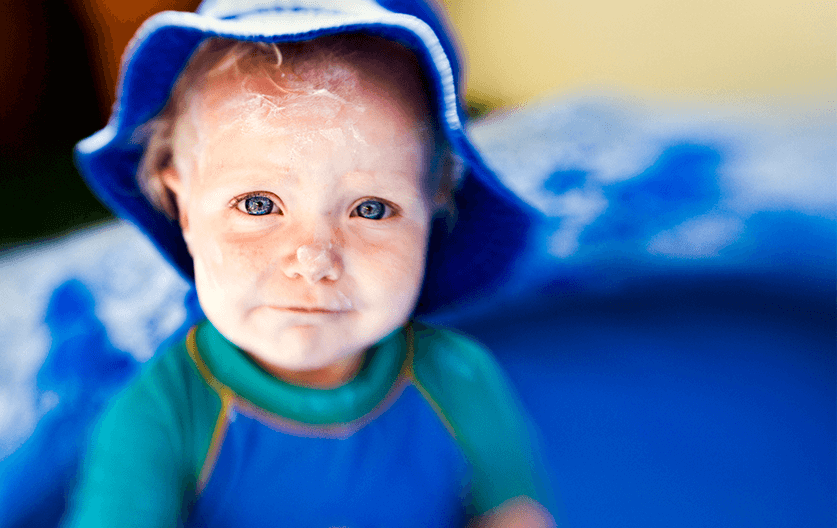- Home
- Mind & body
- What is baby heat rash and how do you treat it?
At CBHS we help you manage your health challenges. We believe in offering you the services, support and tools you need to live your best life.
Health and Wellness Programs are available to support eligible members towards a healthier lifestyle. Each Health and Wellness Program is subject to its own eligibility criteria.
Contact us for more information and to confirm your eligibility for a program.
What is baby heat rash and how do you treat it?

Heat rash is a common complaint for newborn babies. It can be uncomfortable and irritating, especially when it occurs on the face, groin or around the nappy area.
What is heat rash?
Heat rash happens when sweat glands become blocked and inflamed in heat and high humidity. This can prevent babies getting rid of sweat as well as they need to. The sweat gets trapped beneath the skin, causing discoloration, blisters, or lumps. Heat rash – also known as prickly heat or miliaria - can range in severity from mild irritation and itchiness to infection and fever.
Heat rash is common in newborn babies because their sweat glands haven’t had time to properly develop. It’s more uncomfortable than serious, and relatively easy to treat.
What are the symptoms of heat rash?
- Small red spots or blisters, often clear, clustered on the face or in the folds of skin, often in the nappy area
- Itching, prickling, irritating sensations
- Slight swelling and redness on the affected area
Symptoms usually last no more than two to three days. More severe cases can last a week or longer and may need antibiotic treatment.
Use this Symptom checker from HealthDirect to see if your child has heat rash.
What causes heat rash?
Heat rash is caused by a combination of heat and humidity, In children, sweating is the main way they regulate body temperature and hot muggy conditions will increase their sweating and increase the chances of heat rash.
Here are some common causes of heat rash:
Skin folds – places where your pores are more likely to get blocked are where your sweat has less chance of escaping, and where the most amount of skin-to-skin friction occurs. This is especially true for babies and their multitude of skin folds, especially around the neck and inner thighs.
Friction and clothing – dressing your baby in excessive clothing in hot temperatures, or in synthetic clothing that doesn’t allow sweat to evaporate, lead to heat rash.
Bed stay – long periods spent lying in bed can cause heat rash, in much the same way that friction and clothing can.
Immature sweat ducts – baby’s sweat ducts are developing along with the rest of them, and in cases of heat, their pores may not be able to handle intense heat.
Types of heat rash
There are three types of heat rash
Mild | Miliaria crystallina – appears as clear blisters that can be removed through gentle friction, like wiping with a moist towel.
Moderate | Miliaria rubra – appears as bumpy spots that can bring on feelings of irritation and itchiness. May result in rash and pimple-like blisters.
Severe | Miliaria profunda – appears as papules (elevation in the skin with no liquid), and occurs deeper in the flesh than crystallina and rubra. The feeling is generally described as burning rather than itching.
How to treat heat rash
Usually, heat rash will resolve itself. However, there are some simple ways to prevent and take care of heat rash:
Preventing heat rash – Avoid direct contact with the sun on hot days, make sure your baby isn’t wearing excessive or uncomfortable materials (like wool or scratchy fabrics), keep them properly hydrated and make sure there is adequate ventilation.
Taking care of heat rash – Bathe your baby in cool or lukewarm water but avoid excessive bathing as this can reduce the natural oils designed to protect baby’s skin. Avoid plastic covered mattresses in your baby’s cot. Your GP or pharmacist can advise on creams if you feel extra attention is called for.
When you should take your baby to the doctor – If your baby appears unwell, feverish, is difficult to rouse, or if the rash lasts more than three days you should seek medical attention. Otherwise if your baby’s blisters become infected, you should take them to a GP.
Sources:
https://www.dermcoll.edu.au/atoz/miliaria/
https://www.healthdirect.gov.au/heat-rash
https://www.mayoclinic.org/diseases-conditions/heat-rash/symptoms-causes/syc-20373276
All information contained in this article is intended for general information purposes only. The information provided should not be relied upon as medical advice and does not supersede or replace a consultation with a suitably qualified healthcare professional.
Health and wellbeing
programs & support
You Belong to More with CBHS Hospital cover:
- Greater choice over your health options including who treats you
- Get care at home with Hospital Substitute Treatment program
- Free health and wellbeing programs to support your health challenges
Live your healthiest, happiest life with CBHS Extras cover:
- Benefits for proactive health checks e.g. bone density tests, eye screenings
- Keep up your care with telehealth and digital options
- Save on dental and optical with CBHS Choice Network providers
